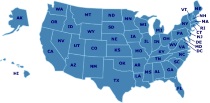Manipulatives
The use of manipulatives are a creative and fun way to introduce and reinforce learning, especially in the area of mathematics.
Resources
Pattern Blocks and Boards
This set of 10 simply designed colorful wooden blocks and pattern boards includes 100 blocks in six different shapes and colors. They help develop shape recognition and spatial relationship skills. The contents store neatly in a durable wooden case. This games was awarded the Scholastic Parent & Child's 2004 "Top 22 Toys that Make Kids Think" award.
Idea Book For Cuisenaire Rods At The Intermediate Level
Grades 2-5. Idea Book designed for use with Cuisenaire Rods.
Flip Over Math Manipulatives
Grades 1-5. Tub of over 500 manipulatives includes Pattern Blocks, Connecting People, Cuisenaire Rods, Coins, and Bean Counters and can be used with the Flip Over Math Books. This 49 page book (others sold separately) is written to NCTM Standards and provide hands on activities from basic math skills to advanced problem solving.
Cuisenaire Rods Multi-Pack
Grades Pre K & up. An economical way to bring rods into the classroom. Pack contains six sets of 74 rods, six trays with, and Teacher's Guide. For use with 12-18 students.
Bead Sequencing Set
Stack the durable, brightly colored wooden beads on 5 hardwood dowels in sequence to match the design on one of the pattern cards. Builds complex reasoning skills as well as sorting and coordination. Includes over 45 brilliantly colored beads, 5 dowels, and 10 patterns that increase in difficulty.
Idea Book For Cuisenaire Rods At The Primary Level
Grades K-4. Each 120 page book contains worksheets and has selected activities that cover the major math standards. Each page outlines the grade level, materials needed, settings, learning experiences, and are based on NCTM Standards.
Using Manipulatives in Your Homeschool
Math-U-See Users Group
This email group is for lovers and users of the Math-U-See program.
5 DIY Manipulatives for Preschool and Kindergarten
These manipulatives are easy to make at home. They provide early learning supplies for anyone on a budget.
Virtual Manipulatives for Interactive Mathematics
This website features online games and interactive activities designed to help children learn and understand mathematical concepts. You can choose any grade level from pre-K to 12, and subjects including numbers and operations, algebra, geometry, measurements, data analysis, and probability. You'll find virtual peg boards, geoboards, fractals, charts, games, and much more.
How to Make the Most of Math Manipulatives
Marilyn Burns discusses creative and effective ways to use manipulatives to teach math. Much of her information is oriented towards classroom instruction, but there is great information for homeschoolers too. She discusses the seven "musts" for using manipulatives, how to introduce a Geoboard, pattern block activities, and more.
Featured Resources
As an Amazon Associate, we earn from qualifying purchases. We get commissions for purchases made through links on this site.
Visual Brainstorms
Children who love word games, logic puzzles, secret codes, mazes, and math mysteries will stretch their mental muscles with Visual Brain Storms. This set of 100 cards, each of which includes a humorous, full-color drawing, promises "the world's best brainteaser questions." The characters in the questions often have funny names (Professor Pith Bugby pops up often) or faces or dilemmas to solve. The answers and explanations are on the back of each card, along with a related bonus question. Many of...
Learning Styles: Reaching Everyone God Gave You to Teach
This book offers helpful and practical strategies about the different ways that kids acquire information and learn, and then use that knowledge. Kids' behavior is often tied to a particular learning style and understanding that fact will help parents respond to their child in ways that decrease frustration and increase success, especially in a homeschooling environment.
Homeschooling Essentials: A Practical Guide to Getting Started
If you're ready to begin homeschooling, then the experiences of others can offer valuable help and encouragement as you jump into this new adventure. This practical guide answers common questions, helps you navigate the legalities of homeschooling, talks about the practical side of homeschooling and different methods, offers resources and gives advice about high school.
Classical Education & The Home School
Classical education is an idea whose time has come again. When parents see the failures of modern education, they look for better solutions and classical education is one that has been tested in the past and found to be good. For the Christian home educator, the classical education model is a path to joy and success.
Real Learning: Education in the Heart of the Home
This book is not about "school at home"--it is about something better. It is about Real Learning. Homeschooling pioneer Charlotte Mason wrote with great wisdom about providing young minds with a living books education. She urged teachers to present great ideas and stand back, allowing students to form relationships with the ideas. Elizabeth Foss carries Miss Mason's philosophy from the idealto the real. How does the busy home-educating mom balance the various needs of a houseful of children? How...











